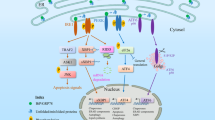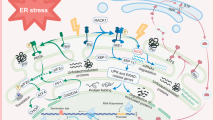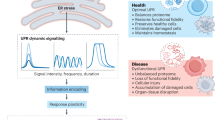Abstract
Neurodegenerative diseases are often associated with dysfunction in protein quality control. The endoplasmic reticulum (ER), a key site for protein synthesis, senses stressful conditions by activating the unfolded protein response (UPR). In this study we report the creation of a novel mouse model in which GRP78/BiP, a major ER chaperone and master regulator of UPR, is specifically eliminated in Purkinje cells (PCs). GRP78-depleted PCs activate UPR including the induction of GRP94, PDI, CHOP and GADD34, feedback suppression of eIF2α phosphorylation and apoptotic cell death. In contrast to current models of protein misfolding in which an abnormal accumulation of ubiquitinated protein is prominent, cytosolic ubiquitin staining is dramatically reduced in GRP78-null PCs. Ultrastructural evaluation reveals that the ER shows prominent dilatation with focal accumulation of electron-dense material within the ER. The mice show retarded growth and severe motor coordination defect by week 5 and cerebellar atrophy by week 13. Our studies uncover a novel link between GRP78 depletion and reduction in cytosolic ubiquitination and establish a novel mouse model of accelerated cerebellar degeneration with basic and clinical applications.
Similar content being viewed by others

Log in or create a free account to read this content
Gain free access to this article, as well as selected content from this journal and more on nature.com
or
Abbreviations
- ER:
-
endoplasmic reticulum
- ERAD:
-
ER-associated protein degradation
- PCs:
-
Purkinje cells
- UPR:
-
unfolded protein response
References
Rubinsztein DC . The roles of intracellular protein-degradation pathways in neurodegeneration. Nature 2006; 443: 780–786.
Malhotra JD, Kaufman RJ . The endoplasmic reticulum and the unfolded protein response. Semin Cell Dev Biol 2007; 18: 716–731.
Zhao L, Longo-Guess C, Harris BS, Lee JW, Ackerman SL . Protein accumulation and neurodegeneration in the woozy mutant mouse is caused by disruption of SIL1, a cochaperone of BiP. Nat Genet 2005; 37: 974–979.
Lee JW, Beebe K, Nangle LA, Jang J, Longo-Guess CM, Cook SA et al. Editing-defective tRNA synthetase causes protein misfolding and neurodegeneration. Nature 2006; 443: 50–55.
Hara T, Nakamura K, Matsui M, Yamamoto A, Nakahara Y, Suzuki-Migishima R et al. Suppression of basal autophagy in neural cells causes neurodegenerative disease in mice. Nature 2006; 441: 885–889.
Anttonen AK, Mahjneh I, Hamalainen RH, Lagier-Tourenne C, Kopra O, Waris L et al. The gene disrupted in Marinesco-Sjögren syndrome encodes SIL1, an HSPA5 cochaperone. Nat Genet 2005; 37: 1309–1311.
Senderek J, Krieger M, Stendel C, Bergmann C, Moser M, Breitbach-Faller N et al. Mutations in SIL1 cause Marinesco-Sjögren syndrome, a cerebellar ataxia with cataract and myopathy. Nat Genet 2005; 37: 1312–1314.
Lee AS . The glucose-regulated proteins: stress induction and clinical applications. Trends Biochem Sci 2001; 26: 504–510.
Hendershot LM . The ER function BiP is a master regulator of ER function. Mt Sinai J Med 2004; 71: 289–297.
Bertolotti A, Zhang Y, Hendershot LM, Harding HP, Ron D . Dynamic interaction of BiP and ER stress transducers in the unfolded-protein response. Nat Cell Biol 2000; 2: 326–332.
Luo S, Mao C, Lee B, Lee AS . GRP78/BiP is required for cell proliferation and protecting the inner cell mass from apoptosis during early mouse embryonic development. Mol Cell Biol 2006; 26: 5688–5697.
Sillitoe RV, Joyner AL . Morphology, molecular codes, and circuitry produce the three-dimensional complexity of the cerebellum. Annu Rev Cell Dev Biol 2007; 23: 549–577.
Weitzmann A, Volkmer J, Zimmermann R . The nucleotide exchange factor activity of Grp170 may explain the non-lethal phenotype of loss of Sil1 function in man and mouse. FEBS Lett 2006; 580: 5237–5240.
Weitzmann A, Baldes C, Dudek J, Zimmermann R . The heat shock protein 70 molecular chaperone network in the pancreatic endoplasmic reticulum - a quantitative approach. FEBS J 2007; 274: 5175–5187.
Rutkowski DT, Kang SW, Goodman AG, Garrison JL, Taunton J, Katze MG et al. The role of p58IPK in protecting the stressed endoplasmic reticulum. Mol Biol Cell 2007; 18: 3681–3691.
Petrova K, Oyadomari S, Hendershot LM, Ron D . Regulated association of misfolded endoplasmic reticulum lumenal proteins with P58/DNAJc3. EMBO J 2008; 27: 2862–2872.
Fu Y, Wey S, Wang M, Ye R, Liao CP, Roy-Burman P et al. Pten null prostate tumorigenesis and AKT activation are blocked by targeted knockout of the stress response chaperone GRP78/BiP in prostate epithelium. Proc Natl Acad Sci USA 2008; 105: 19443–19448.
Barski JJ, Dethleffsen K, Meyer M . Cre recombinase expression in cerebellar Purkinje cells. Genesis 2000; 28: 93–98.
Dong D, Ni M, Li J, Xiong S, Ye W, Virrey JJ et al. Critical role of the stress chaperone GRP78/BiP in tumor proliferation, survival and tumor angiogenesis in transgene-induced mammary tumor development. Cancer Res 2008; 68: 498–505.
Rao RV, Bredesen DE . Misfolded proteins, endoplasmic reticulum stress and neurodegeneration. Curr Opin Cell Biol 2004; 16: 653–662.
Hetz CA, Soto C . Stressing out the ER: a role of the unfolded protein response in prion-related disorders. Curr Mol Med 2006; 6: 37–43.
Ni M, Lee AS . ER chaperones in mammalian development and human diseases. FEBS Lett 2007; 581: 3641–3651.
Marciniak SJ, Yun CY, Oyadomari S, Novoa I, Zhang Y, Jungreis R et al. CHOP induces death by promoting protein synthesis and oxidation in the stressed endoplasmic reticulum. Genes Dev 2004; 18: 3066–3077.
Marciniak SJ, Ron D . Endoplasmic reticulum stress signaling in disease. Physiol Rev 2006; 86: 1133–1149.
Molinari M, Galli C, Piccaluga V, Pieren M, Paganetti P . Sequential assistance of molecular chaperones and transient formation of covalent complexes during protein degradation from the ER. J Cell Biol 2002; 158: 247–257.
Yoshida H . ER stress and diseases. FEBS J 2007; 274: 630–658.
Bjorkoy G, Lamark T, Brech A, Outzen H, Perander M, Overvatn A et al. p62/SQSTM1 forms protein aggregates degraded by autophagy and has a protective effect on huntingtin-induced cell death. J Cell Biol 2005; 171: 603–614.
Seibenhener ML, Geetha T, Wooten MW . Sequestosome 1/p62--more than just a scaffold. FEBS Lett 2007; 581: 175–179.
Lee AS . The ER chaperone and signaling regulator GRP78/BiP as a monitor of endoplasmic reticulum stress. Methods 2005; 35: 373–381.
Suzuki T, Lu J, Zahed M, Kita K, Suzuki N . Reduction of GRP78 expression with siRNA activates unfolded protein response leading to apoptosis in HeLa cells. Arch Biochem Biophys 2007; 468: 1–14.
Li J, Ni M, Lee B, Barron E, Hinton DR, Lee AS . The unfolded protein response regulator GRP78/BiP is required for endoplasmic reticulum integrity and stress-induced autophagy in mammalian cells. Cell Death Differ 2008; 15: 1460–1471.
Pyrko P, Schonthal AH, Hofman FM, Chen TC, Lee AS . The unfolded protein response regulator GRP78/BiP as a novel target for increasing chemosensitivity in malignant gliomas. Cancer Res 2007; 67: 9809–9816.
Plemper RK, Bohmler S, Bordallo J, Sommer T, Wolf DH . Mutant analysis links the translocon and BiP to retrograde protein transport for ER degradation. Nature 1997; 388: 891–895.
Skowronek MH, Hendershot LM, Haas IG . The variable domain of nonassembled Ig light chains determines both their half-life and binding to the chaperone BiP. Proc Natl Acad Sci USA 1998; 95: 1574–1578.
Ushioda R, Hoseki J, Araki K, Jansen G, Thomas DY, Nagata K . ERdj5 is required as a disulfide reductase for degradation of misfolded proteins in the ER. Science 2008; 321: 569–572.
Reddy RK, Mao C, Baumeister P, Austin RC, Kaufman RJ, Lee AS . Endoplasmic reticulum chaperone protein GRP78 protects cells from apoptosis induced by topoisomerase inhibitors: role of ATP binding site in suppression of caspase-7 activation. J Biol Chem 2003; 278: 20915–20924.
Fu Y, Li J, Lee AS . GRP78/BiP inhibits endoplasmic reticulum BIK and protects human breast cancer cells against estrogen-starvation induced apoptosis. Cancer Res 2007; 67: 3734–3740.
Mimura N, Yuasa S, Soma M, Jin H, Kimura K, Goto S et al. Altered quality control in the endoplasmic reticulum causes cortical dysplasia in knock-in mice expressing a mutant BiP. Mol Cell Biol 2008; 28: 293–301.
Impagnatiello F, Guidotti AR, Pesold C, Dwivedi Y, Caruncho H, Pisu MG et al. A decrease of reelin expression as a putative vulnerability factor in schizophrenia. Proc Natl Acad Sci USA 1998; 95: 15718–15723.
Naidoo N . ER and aging-Protein folding and the ER stress response. Ageing Res Rev 2009; 8: 150–159.
Acknowledgements
We thank Dr. Robert Maxson and the Lee laboratory members for helpful discussion. We thank the University of Southern California/Norris Comprehensive Cancer Center Transgenic Core Facility, the Cell and Tissue Imaging Core Facility, the Translational Pathology Core Facility and the Biostatistics Core Facility for assistance and consultation. This work was supported by the NIH Grants R01-CA027607, R01-CA111700 and the Freeman Cosmetic Chair to ASL.
Author information
Authors and Affiliations
Corresponding author
Additional information
Edited by D Rubinsztein
Supplementary Information accompanies the paper on Cell Death and Differentiation website (http://www.nature.com/cdd)
Rights and permissions
About this article
Cite this article
Wang, M., Ye, R., Barron, E. et al. Essential role of the unfolded protein response regulator GRP78/BiP in protection from neuronal apoptosis. Cell Death Differ 17, 488–498 (2010). https://doi.org/10.1038/cdd.2009.144
Received:
Revised:
Accepted:
Published:
Issue date:
DOI: https://doi.org/10.1038/cdd.2009.144
Keywords
This article is cited by
-
Oxidative stress and apoptosis in Asian honey bees (A. cerana) exposed to multiple pesticides in intensive agricultural landscape
Apidologie (2022)
-
Endoplasmic reticulum chaperone BiP/GRP78 knockdown leads to autophagy and cell death of arginine vasopressin neurons in mice
Scientific Reports (2020)
-
Neurite outgrowth inhibitory levels of organophosphates induce tissue transglutaminase activity in differentiating N2a cells: evidence for covalent adduct formation
Archives of Toxicology (2020)
-
Genetic association of promoter in GRP78 gene with nasopharyngeal carcinoma in a Chinese population
International Journal of Clinical Oncology (2019)
-
Polystyrene nanoparticles affect the innate immune system of the Antarctic sea urchin Sterechinus neumayeri
Polar Biology (2019)


